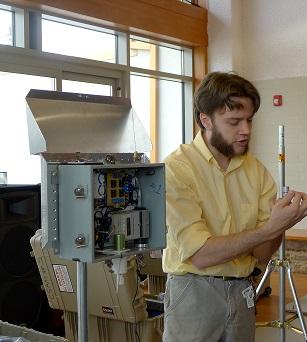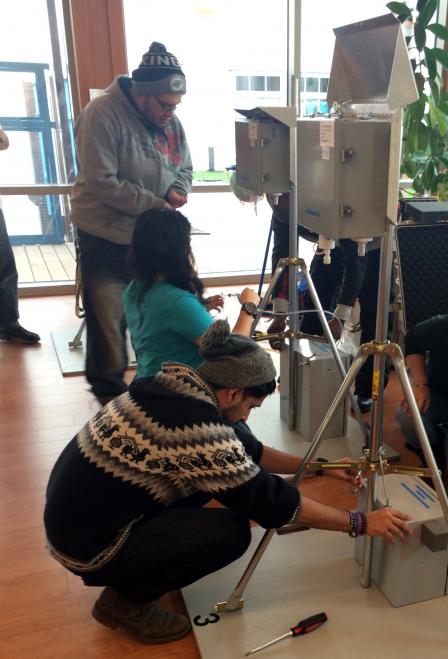Citizen Science in Newark, New Jersey
EPA air sensors help Ironbound Community in Newark, N.J.
Published in October 2015
 Researcher Sam Garvey demonstrates an air monitor.
Researcher Sam Garvey demonstrates an air monitor.
The Ironbound neighborhood of Newark, N.J., is surrounded by a number of industries and a dense network of roadways and other transport routes. Residents of the community are getting a technological boost from EPA in their efforts to learn about sources of harmful air pollutants and improve public health.
Thanks to a new type of portable air sensor developed by EPA researchers, community members took to the streets in the spring of 2015 to monitor levels of particulate matter and nitrogen oxide – pollutants that cause short- and long-term health effects and are regulated under the Clean Air Act.
“Our goal is to get good on-the-ground air quality data for our environmental justice community. Data that is collected, understood, and used by those being directly impacted by the pollution,” says Molly Greenberg, environmental justice policy manager for the Ironbound Community Corporation (ICC), a 46-year-old local non-profit that runs various education and advocacy programs in the neighborhood. “The closest [EPA] air monitor for our community is not near the major sources [of pollution] and residents.”
 Citizen scientists in the Ironbound community assemble air monitors.Greenberg says that many of the 50,000 residents of Ironbound are overburdened by polluting facilities and air pollutants from the second largest seaport in the country, an international airport, and rail lines. Twenty-five percent of the children in the community suffer from asthma, which is three times the state average.
Citizen scientists in the Ironbound community assemble air monitors.Greenberg says that many of the 50,000 residents of Ironbound are overburdened by polluting facilities and air pollutants from the second largest seaport in the country, an international airport, and rail lines. Twenty-five percent of the children in the community suffer from asthma, which is three times the state average.
“Ironbound is home to a myriad of sources of air pollution,” Greenberg says. “This project provides us with a way to better understand the potential health and environmental impacts on our community. Having that information strengthens the advocacy work and helps to create change.”
Tim Barzyk, EPA’s lead on this effort explains, “EPA is also interested in how citizen science technologies can be used to support decisions that improve community health.”
To address this need, EPA provided a custom air sensor package, called the Citizen Science Air Monitor or CSAM, and technical training to the ICC. “Development of the CSAM sensor package for this pilot study has provided EPA an opportunity to examine emerging technologies and how such devices might be successfully deployed in citizen science activities,” says Ron Williams, an EPA researcher.
The technical resources developed for the Ironbound community can be used by other communities across the country to develop their own air monitoring programs in areas where pollution is a concern. The resources are available on the Air Sensor Toolbox for Citizen Science (see below).
________________________________
Air Sensor Citizen Science Toolbox
EPA is helping people use and understand low-cost air quality sensors.
EPA is advancing air sensor monitoring technology on many fronts to help meet the demand from communities and citizens for information about their local air quality. One effort is the development of the Air Sensor Citizen Science Toolbox, an online resource that provides information and guidance on new low-cost compact technologies for measuring air quality.
The toolbox features resources developed by EPA researchers that can be used by citizens to effectively collect, analyze, interpret, and communicate air quality data. The resources include:
- Sampling methodologies
- Generalized calibration/validation approaches
- Measurement methods options
- Data interpretation guidelines
- Education and outreach
- Low cost sensor performance information
- Community air monitoring training videos
